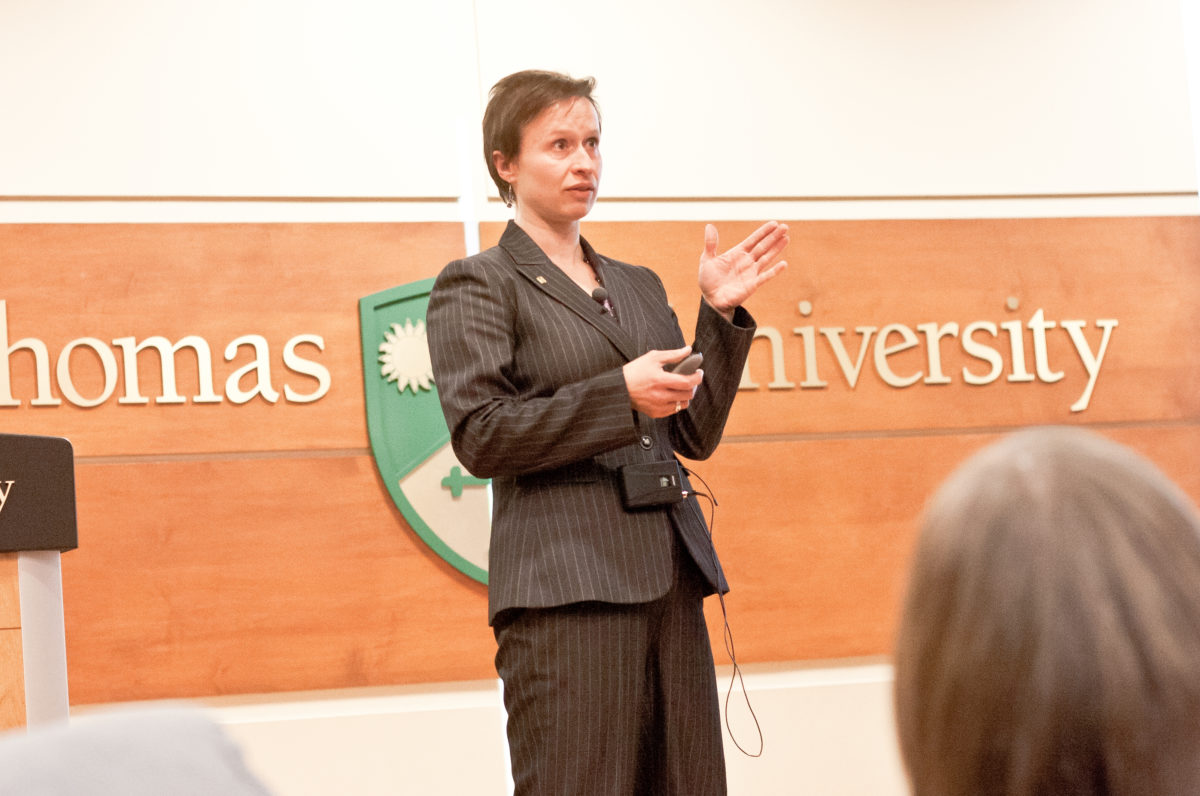 St. Thomas University is considering raising tuition beyond the provincial cap of $150 and cutting $100,000 in academic scholarships to deal with a $600,000 projected deficit for the 2013-2014 school year.
St. Thomas University is considering raising tuition beyond the provincial cap of $150 and cutting $100,000 in academic scholarships to deal with a $600,000 projected deficit for the 2013-2014 school year.
Vice president of finance Lily Fraser presented the budget to roughly 130 students and faculty who came to a Town Hall in Kinsella Auditorium last week. Many students took advantage of question period to voice their concerns.
“I’m really honoured to go here and I’m a little bit scared for the future of it,” fifth-year student Kate Price said.
Price chose STU over big schools in Nova Scotia like Dalhousie and King’s.
“When tuition does rise … I wonder what classrooms will look like, I wonder what St. Thomas education is going to look like, I wonder what the experience will look like and I’m scared for that.”
The proposed $100,000 decrease in academic scholarships comes after a right-to-information request by STU journalism student Matt Tidcombe showed the men’s hockey team’s 19 players received $111,583 in scholarships for the 2012-2013 season. The team won three of their 28 games this year and finished dead last.
Khairunnisa Intiar, a fourth-year student, asked if it was possible the cuts to academic scholarships could also include cuts to sports scholarships.
“Hear hear,” someone in the audience said followed by applause.
“We did look at that and on a comparative level St. Thomas is one of the lowest in Atlantic Canada for the amount of athletic scholarships we give out overall,” STU president Dawn Russell said.
The finance committee will submit a proposed budget to the board of governors in mid-May after considering what was heard at the Town Hall meeting, according to Russell. STU’s two main sources of revenue are the provincial operating grant and tuition. She said STU’s operating grant is only 84 per cent of the provincial average. At $13.5 million, the provincial grant will be the same next year as it was this year.
“There’s no denying the reality of the fiscal gap created by St. Thomas’ inequitably low provincial operating grant and our low tuition fee levels,” Russell said.
The university’s operating costs rise between three and four per cent every year due to increases in faculty wages and energy bills. There were also approximately 100 fewer students this year than budgeted for. These 100 students accounted for around $350,000 less in revenue for the university, depending on if they would have been domestic or international students.
Fraser said the administration has noticed fewer New Brunswick students applying, especially male students. About 75 per cent of STU’s students come from within the province.
STU is forecasting a slight surplus of $11,000 in general operations for 2012-2013.
The proposed budget assumes there will be 2,300 students in the fall. Russell said the university has increased recruiting internationally and across Canada.
STU has already reduced the number of courses it offers. Last year there were 392.5 six-credit-hour courses compared to 385.5 this year and 378.5 next year.
“It’s a mistake to think that because the university is larger, that the liberal arts program is larger or that the program offerings are larger. That actually isn’t the reality. So that’s an assumption that you’re making that’s not accurate,” Russell said.
STU has the third-largest liberal arts program in Atlantic Canada, higher than Mount Allison and the University of New Brunswick.
Many students at the Town Hall questioned why they would choose STU over UNB with rising tuition and a decreasing selection of courses and scholarships.
“By increasing tuition and decreasing bursaries and scholarships students are going to be less attracted to coming to the university, and what other students have been saying is why wouldn’t we go to UNB then where we’re paying maybe a couple hundred dollars more but we’re getting more resources and classes,” a STU student said.
“I honestly think you’re definitely going to lose students.”
Vice president academic Barry Craig said last year STU has the lowest tuition in the province and had a decrease in enrolment while Mount Allison University has the highest tuition in New Brunswick and saw an increase in enrolment.
Nathan Paton, third-year student, asked why the administration thinks STU should receive the same provincial grant as larger institutions. Craig said in previous years the university has undervalued the education STU offers.
“The cost of delivering a BA at St. Thomas is essentially the same cost as delivering a BA at UNB or Mount A. I would maintain the quality of our BA is equal or superior to either of those institutions,” Craig said.
STU is looking at increasing tuition to the provincial average. If done over three years this would be an increase of $284 each year. Tuition at STU has increased by 13.5 per cent over the last seven years.
STU still has the lowest tuition in the province at $4,945 for 2012-2013. UdeM is the next lowest at $5,292.
Students’ union president John Hoben asked how the university would increase tuition by more than the provincial cap of $150. The provincial government capped tuition increases at $175 last year and $200 the year before. Fraser said the university’s board of governors has the authority to change tuition at its discretion.
The students’ union sent out a press release in reaction to the proposed tuition hike.
“What the university is proposing is excessive, unprecedented, and reckless,” Hoben said. “The government needs to make swift and decisive action to protect students against absurd and excessive tuition hikes.”
The press release says members of the union will be meeting with the representatives from the Department of Post-Secondary Education, Training, and Labour.

